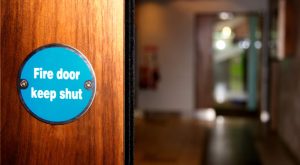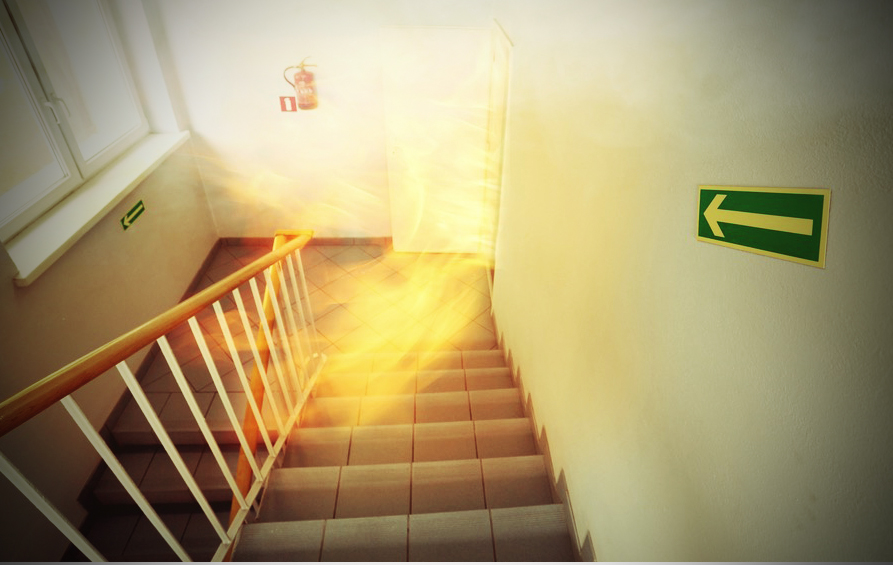Posted on August 2, 2019 in General Info
Page Contents
Learn about fire doors and the standards you need to make sure a property you own or manage meets the required fire door safety level.

What do you need to know?
What are fire doors and why do they matter?
Fire doors are a really important element of your fire safety strategy. Used correctly, they stop fires from spreading through a building, giving people time to escape and the Fire Brigade time to attend and potentially save your premises or life.
Getting the right fire doors in place is an important responsibility, though you will also need to consider fire detection and sprinklers.
Why do you need to provide fire door safety?
- They are specifically designed to withstand fire for up to 30 minutes.
- They are a legal requirement for flats which open onto communal areas shared with other tenants. This is to make sure crucial escape routes are protected if a fire breaks out.
- They are designed to automatically close behind you in the event of fire, holding flames back and stopping the spread of the fire and toxic smoke into escape routes, corridors and other flats in the block.
Did you know?
Property owners are required by law (The Regulatory Reform (Fire Safety) Order 2005) to make sure premises reach required standards of fire safety.
The overview
Fire door or normal door – what’s the difference?
If a fire door is properly made by a BWF certified manufacturer, with compatible parts, and certified by an accredited third party, it should hold back a fire for 30 minutes or more.
However, the components – hinges, seals, handles and glazing – are as important as the door itself. This is because, in a fire, doors can warp, move and allow smoke and fire through the opening. The seals and the gaps between the door frame and the wall are really vital too. They also stop smoke and fire spreading as quickly.
If a fire door isn’t properly installed, or you don’t use all the right seals and components like letterboxes that are fire-safe too, it can fail in under 5 minutes.
Dos, don’ts and details
Tips for fire door installation and use
There are some simple must-knows when it comes to fire doors and their safe use and installation:
Do…
- Get professionals to install your fire doors.
- Check your door’s certification – look for British Standard (BS) Parts 22 and 31 or BS EN 1154.
- Make sure there are combines smoke and fire seals around the door.
- Check the handles close properly.
- Make sure that seals and other components like letter boxes are fire-safe too.
- Make sure you have appropriate door closure mechanisms – the wrong ‘closers’ can physically damage frames and hinges through slamming, as well as causing injury to the people who use the doors which will affect the fire door safety.
Don’t…
- Prop them open or let your people prop them open – doors can save lives if they are shut.
- Install fire doors yourself – the components and seals are as important as the door itself.
- Let tenants replace fire doors if your building is a block of flats.
- Remove the self closing device fitted to the door.
- Leave damaged doors in use – always have them repaired or replaced ASAP.
Who is responsible for fire doors?
If you are responsible for a property, it’s likely that you need to make some fire safety precautions to keep the people who use it safe. This includes almost all buildings, places and structures other than individual private homes – that’s individual flats in a block or family homes. Property manager’s responsibilities include shared areas in houses in multiple occupation (HMOs), blocks of flats and maisonettes.
What about old doors – are they OK?
There is a difference between modern fire doors and their requirements and older type doors, often called ‘Notional fire doors’. These doors may have been in place for many years and met earlier standards of manufacture and legislation. However, this doesn’t mean that they are now not fit for purpose, providing they are still in good condition they will still provide the service for which they were intended.
Modern doors are equipped with what’s called intumescent strips and cold smoke seals. Older ‘notional’ doors may not have these fitted, and are often fitted into frames with a 1 inch or 25 mm door stop. The ‘notional’ door may be suitable in place if it is not warped or gapped to the extent that it requires replacement, its replacement will be a modern style fire door. Where doors are replaced that are required to be fire resisting they should not be replaced by ordinary doors and the person replacing the door should ensure that the door is a fire door.
Can I have a window in a fire door?
Absolutely, yes. Some fire doors are fitted with glazing – what’s termed a ‘vision panel’, these are subject to the test procedure when constructed and you are not allowed to retrofit glazing by cutting the door unless this is done by a door specialist, the BWF-CERTIFIRE scheme will be able to provide further information if this is a requirement.
Hinges and letter boxes
Fire doors will have at least 3 hinges with a melting point above 800 degrees centigrade and apertures for glazing and for letter boxes should be in place at testing. Arson Reduction letterboxes are available as a retrofit to the existing aperture and can be made available from the Fire Brigade in certain instances.
How often do I need to get fire doors checked?
It depends on your circumstances. Though BWF-CERTFIRE Fire Door Safety Best Practice Guide suggests every 6 months, we believe that a risk-assessed approach is also appropriate for many. However, if your building is a hotel, or is home to anyone who might not be able to quickly respond to or escape from a fire, 6-monthly checks are essential.
For information on our fire door installation and maintenance please call one of our friendly team on 0845 604 1288 or visit Protech Fire Door Solutions.
Categories
- Building Maintenance
- Cleaning
- Electrical
- Gardening
- General Info
- Our Service
- Pest
- Security
- Uncategorized
- Waste Solutions
Archive
- April 2024
- March 2024
- February 2024
- January 2024
- December 2023
- November 2023
- August 2023
- April 2023
- February 2023
- January 2023
- December 2022
- November 2022
- October 2022
- September 2022
- August 2022
- July 2022
- June 2022
- May 2022
- April 2022
- March 2022
- February 2022
- January 2022
- December 2021
- October 2021
- September 2021
- August 2021
- July 2021
- June 2021
- May 2021
- April 2021
- March 2021
- February 2021
- January 2021
- December 2020
- November 2020
- October 2020
- September 2020
- August 2020
- July 2020
- June 2020
- May 2020
- April 2020
- March 2020
- February 2020
- January 2020
- December 2019
- November 2019
- October 2019
- September 2019
- August 2019
- July 2019
- June 2019
- May 2019
- April 2019
- March 2019
- February 2019
- January 2019
- December 2018
- November 2018
- October 2018
- September 2018
- August 2018
- July 2018
- June 2018
- May 2018
- April 2018
- March 2018
- February 2018
- January 2018
- December 2017
- November 2017
- October 2017
- September 2017
- August 2017
- July 2017
- June 2017
- May 2017
- April 2017
- March 2017
- February 2017
- January 2017
- December 2016
- November 2016
- October 2016
- September 2016
- August 2016
- July 2016
- June 2016
- May 2016
- April 2016
- March 2016
- February 2016
- January 2016
- December 2015
- November 2015
- October 2015
- September 2015
- August 2015
- July 2015
- June 2015
- May 2015
- April 2015
- March 2015
- February 2015
- January 2015
- October 2014
- May 2013
- April 2013
- November 2011
- September 2011
- June 2011
- January 2011
- December 2010
- November 2010


